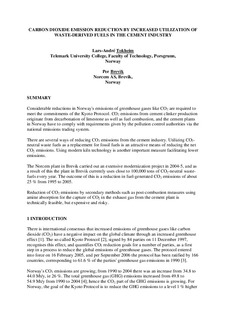Carbon dioxide emission reduction by increased utilization of waste-derived fuels in the cement industry
Conference report
Permanent lenke
http://hdl.handle.net/11250/2438512Utgivelsesdato
2007Metadata
Vis full innførselSamlinger
Originalversjon
Conference object. International conference on sustainability in the cement and concrete industry. Lillehammer, September 16-19, 2007Sammendrag
Considerable reductions in Norway's emissions of greenhouse gases like CO2 are required to meet the commitments of the Kyoto Protocol. CO2 emissions from cement clinker production originate from decarbonation of limestone as well as fuel combustion, and the cement plants in Norway have to comply with requirements given by the pollution control authorities via the national emissions trading system. There are several ways of reducing CO2 emissions from the cement industry. Utilizing CO2- neutral waste fuels as a replacement for fossil fuels is an attractive means of reducing the net CO2 emissions. Using modern kiln technology is another important measure facilitating lower emissions. The Norcem plant in Brevik carried out an extensive modernization project in 2004-5, and as a result of this the plant in Brevik currently uses close to 100,000 tons of CO2-neutral wastefuels every year. The outcome of this is a reduction in fuel-generated CO2 emissions of about 25 % from 1995 to 2005. Reduction of CO2 emissions by secondary methods such as post-combustion measures using amine absorption for the capture of CO2 in the exhaust gas from the cement plant is technically feasible, but expensive and risky.
